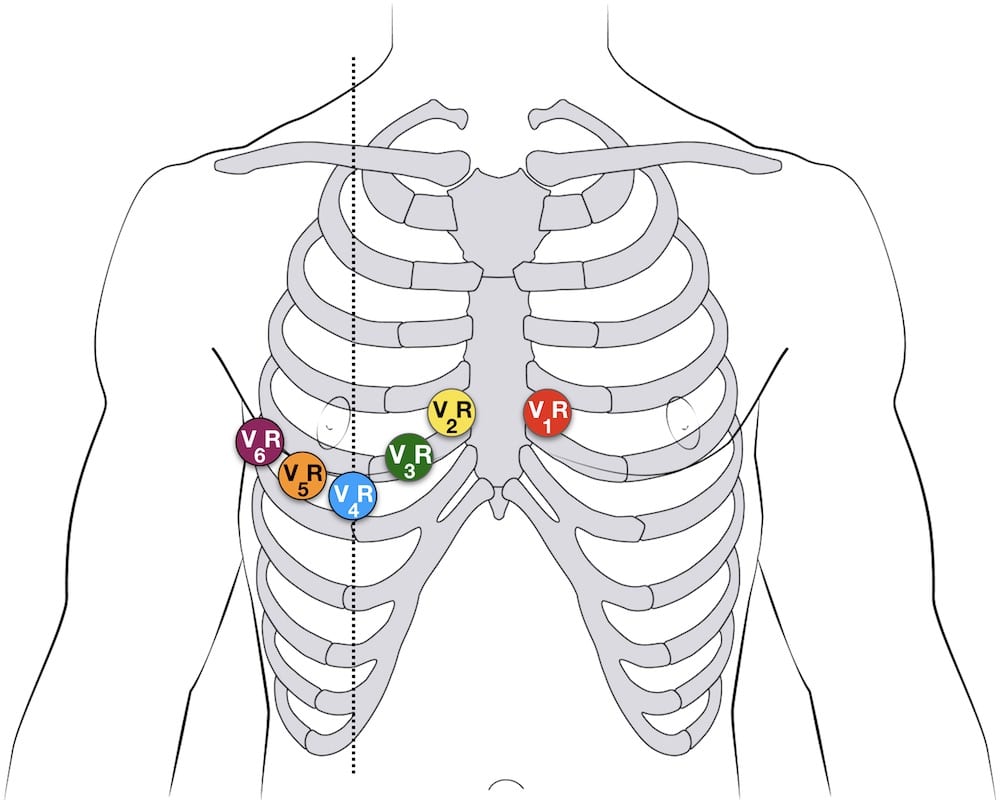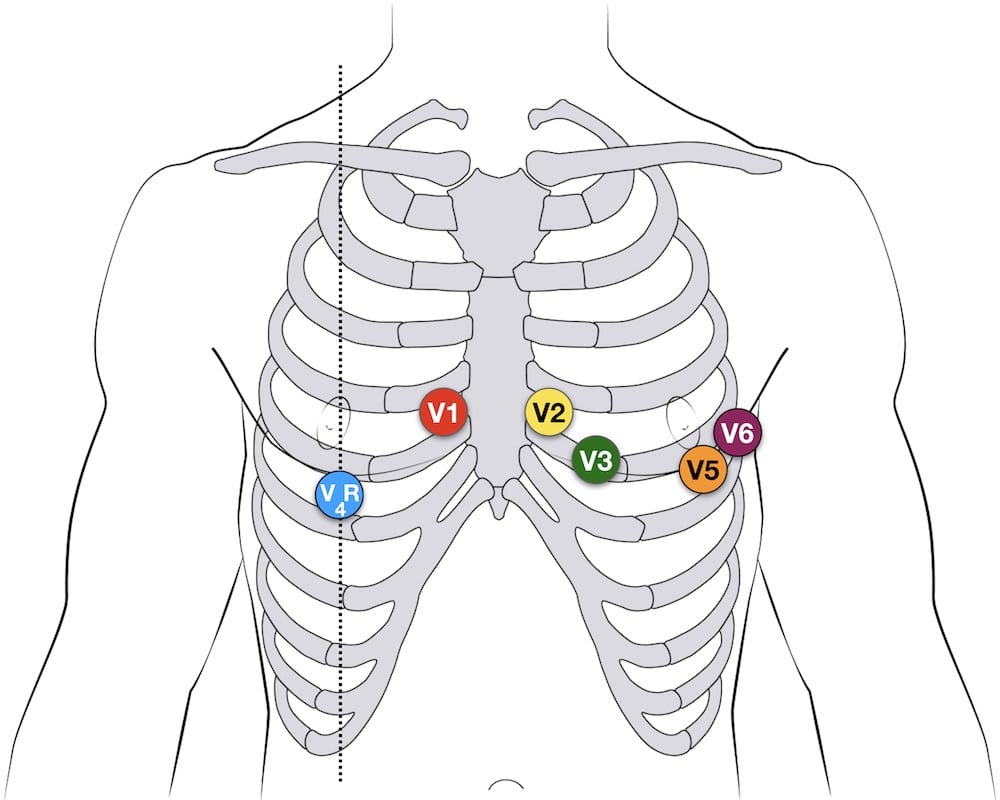To use the Acquistion Module. Isolated posterior MI is less common 3-11 of infarcts.

Ecg Lead Positioning Litfl Ecg Library Basics
ECG Monitoring 1215 Lead PlacementResources.

. Aside from a 12-lead ECG placement theres something known as a 15-lead placement which includes placing leads V4-V6 on the posterior side of the patient below their left scapula see below. To clarify leads will equal. The limb leads can also be placed on the upper arms and thighs.
The overwhelming majority of studies regarding both the diagnostic and prognostic utility of adding posterior and right-sided leads date from the late 1970s to early 2000s. Besides the incidence of isolated posterior MI is not defined and has been reported in studies ranging from 0 to 7-12 18 23. ST-segment elevation was recorded as present if 10 mm 01 mV or more in at least one lead but 05 mm or more was accepted in the posterior leads if the R waves were of low less than 10 mm amplitude.
Aside from a 12-lead ECG placement theres something known as a 15-lead placement which includes placing leads V4-V6 on the posterior side of the patient below their left scapulasee below. The last time I did a posterior EKG was on a guy who told me he last had a posterior wall MI. On most EKg machines the labels areno automatically changed so it is important to cross out the labels for V4-V6 and write in V7-V9.
While the 18-lead ECG is perhaps more sensitive for early detection of ischemia or infarction in practice either should be used for. Posterior infarction accompanies 15-20 of STEMIs usually occurring in the context of an inferior or lateral infarction. Ill do a right 15 or 18 lead if Im really suspicious of something cardiac going on but cant immediately find it on a 12 lead or if I see an inferior wall MI.
ST depression in V1 and V2 with R waves. Suspected right ventricular or posterior infarcts. An ECG lead is a graphical description of the electrical activity of the heart.
Right sided 12 lead ECG lead placement. Chest Precordial Lead Placement. Midway between leads V2 and V4.
In this series of 15 -. V4R into H. From electrodes to limb leads chest leads 12-lead ECG.
A 15 lead ECG is not necessary with every patient but if clinically indicated or a PMI is suspected it may be useful. 4th intercostal space right sternal border. 5th intercostal space anterior axillary line.
Additional notes on 12-lead ECG Placement. Feel for anatomical landmarks on trainer remove electrode from sheet and place adhesive side. Total scene time should not exceed 20 minutes.
For female patients place leads V3-V6 under the left breast. It is also helpful for future clinicians if you note in your read that it is a posterior ECG. ECG limb lead placement diagram.
When viewing the EKG strip V4-V6 on the strip will be referred to as V-13-15. Where do you place a 15 lead ECG. There are three situations where a 15 lead ECG should be performed after a 12 lead ECG.
If you use the Posterior Leads place them into the HEI M Leads on the Acquisition Module. Ensure the trainer is clean. Also damage to the posterior section of the heart is more often associated with an inferior or lateral MI when this is the case the infarcted area size tends to be larger.
A prehospital 12-lead ECG may be initiated and performed on scene but should not extend scene time. They are performed by placing V4 V5 and V6 electrodes in the same intercostal space but continuing into the patients back. 5th intercostal space midclavicular line.
2 patients among the 50 had both RVI and PWMI. Lead ECG taken from 50 IWMI patient s the overall incidence of ST elevation in the posterior chest. See figures 8 9 3.
2-3 Level A Recommendation When a 15-lead or 18-lead ECG machine is not available manipulation of the leads from a standard 12-lead ECG machine allow additional areas of the heart to be imaged4-5 Indications of a posterior wall infarction may include4-513 Changes in V 1 V 3. That is a time when thrombolysis was the mainstay of reperfusion therapy with diagnostic ST-elevation. Watch a video on ECG leadelectrode placement.
15-lead ECG V4R V8 V9 So why arent these leads in our default ECG acquisition. It can be simpler to leave V1 and V2 in their usual positions and just transfer leads V3-6 to the right side of the chest ie. V4V7 V5V8 and V6V9.
Red positive is referenced to white negative and brown positive is referenced to black negative Poster AHA IEC Label Color Color Channel Lead Location. A complete set of right-sided leads is obtained by placing leads V1-6 in a mirror-image position on the right side of the chest see diagram below. The leads V4-V6 are removed and substituted for V7-V9 as shown below.
For instance do not attach an electrode on the right wrist and one on the left upper arm. ECG Monitoring 12 -Lead. In addition the use of the 15-lead ECG confirms the posterior MI and is superior to the findings in the anterior leads.
15 lead Preparation and Placement RL RA V1 V2 V3 V3RV 4R V7 V4 V5 V6 LA LL 1 2 3 LL CAM HD 15 lead Preparation and Placement continued For your convenience you can acquire ECGs from the Acquisition Module. However there should be uniformity in your placement. 4th intercostal space left sternal border.
Posterior leads are helpful in suspected posterior myocardial infarction. Electrodes Placement for Posterior Leads. Lay out labeled leads and plug them into their designated outlets on the 15-lead electronics box.
Before discussing the ECG leads and various lead systems we need to clarify the difference between ECG leads and ECG electrodesAn electrode is a conductive pad that is attached to the skin and enables recording of electrical currents. Enter the patients name and date of birth for all 12- leads day 2 month 3 year 4 on the cardiac monitor if the day is a single digit do not preface with. A posterior wall MI even though the initial 12 lead ECG shows no obvious acute changes The fact that it doesnt directly show up on a standard 12 lead ECG is the reason the posterior wall MI is the most.
Posterior extension of an inferior or lateral infarct implies a much larger area of myocardial damage with an increased risk of left ventricular dysfunction and death. When viewing the EKG strip V4-V6 on the strip will be referred to as V-13-15. Lead Placement for Posterior ECG.
In the fifth intercostal space and the left posterior axillary line. Traditional 15 Electrode Placement Two Channel 5 Electrode Lead Placement In this conguration two channels of ECG data are bipolar. You suspect that the underlying cause of a patients presentation is cardiac eg.
Leads V7-V9 was 26. Basic 12-Lead Placement 1. 15 or 18 lead ECGs can be done with alternate precordial lead placement to assess for posterior- or right-sided disease.
Position trainer in the desired upright or horizontal position. 15-LEAD ECG Zalenski et al lateral posterior reciprocal posterior indicative fight ventricular. Lead Placement for Posterior ECG Resus Review.
Emdocs Net Emergency Medicine Educationposterior Mi Recognition Emdocs Net Emergency Medicine Education

Ecg Lead Positioning Litfl Ecg Library Basics

Ecg Lead Positioning Litfl Ecg Library Basics
Lead Placement For Posterior Ecg Resus Review

The Ultimate 12 Lead Ecg Placement Guide With Illustrations


0 comments
Post a Comment